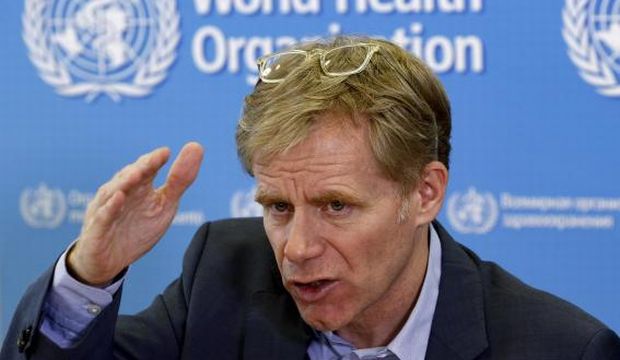
WHO Assistant Director General Aylward gestures during a news conference at the organization’s headquarters in Geneva. (Reuters)
The disease is still raging in parts of Sierra Leone, Dr. Bruce Aylward, an assistant director-general for WHO, warned reporters, and there is still a risk that the trend in Liberia will not be sustained.
Several times throughout this outbreak, including in Liberia, officials have thought the disease’s spread was slowing, only to surge again later. They have often blamed those false lulls on cases being hidden because people were too afraid to seek treatment, wanted to bury their relatives themselves or simply were not in contact with authorities.
But there are some positive signs: There are empty beds in treatment centers in Liberia and the number of burials has declined. There may be as much as a 25 percent week-on-week reduction in cases in Liberia, Aylward said.
Throughout the Ebola outbreak, WHO has warned that its data have been incomplete and the number of cases are likely vastly under-reported. That is still a concern, Aylward said, but the trend nonetheless appears to be real.
“The epidemic [in Liberia] may be slowing down,” he said during a telephone press conference from Geneva. The slowdown could be attributable to a rapid increase in the safe burial of Ebola victims, an uptick in the number of sick people being isolated and major public awareness campaigns on how to stop transmission.
So far, more than 13,700 people have been sickened in the outbreak, which has hit Liberia, Guinea and Sierra Leone hardest. More than 6,300 of those are in Liberia alone.
Aylward cautioned against reading too much into the decline, saying that any let-up in the response could allow the disease to surge again.
“Am I hopeful? I’m terrified the information will be misinterpreted and people would start to think, oh great, this is under control,” he said. “That’s like saying your pet tiger is under control.”
Liberia’s Red Cross said Tuesday that teams collected 117 bodies last week from the county that includes Monrovia, down from the high of 315 in September, and the government reported last week that only about half of the available beds in treatment centers were occupied.
Benoit Carpentier, a spokesman for the International Federation of the Red Cross, warned that it was too early to celebrate those numbers, saying Ebola outbreaks come in waves. He noted that Red Cross figures show deaths are still increasing outside Monrovia.
“This hasn’t dropped off a cliff…There’s a huge risk it wouldn’t be sustained,” said Aylward. “It would be a huge mistake…to think we can scale down the response.”
Instead, experts should redouble their efforts to track all of the people with whom the sick have come into contact—a task that has been nearly impossible in many parts of the outbreak because of the sheer number of infections.
There is also tremendous work still to be done outside of Liberia.
The western areas of Sierra Leone, near the capital, have been seeing a particularly steady increase in cases lately, and the country’s president has warned that Sierra Leone will not win the war against the epidemic until people change their behavior, including avoiding touching the sick and the dead and quickly reporting to health centers if you fall ill.
On Tuesday night, the government numbers showed 26 new confirmed cases were reported in the country’s western districts, which include Freetown, during the previous 24 hours. Similar or higher numbers have been reported every day for those districts in recent days. In Bombali district, in the north, 32 new confirmed cases were reported.
“We’re seeing this thing burning quite hot in parts of Sierra Leone,” Aylward said.
On a visit this weekend to some of those hard-hit areas, President Ernest Bai Koroma said several treatment centers are being built around the country, but that the battle will only be won when people start following the experts’ advice.
If attitudes don’t change, “we will continue to work without results,” he said, according to a government statement released late Tuesday.
Koroma said that areas in the country’s far east—where the outbreak first hit Sierra Leone—have seen a marked decline in cases because they are following the recommendations. Aylward gave a similar explanation, saying that the decline in the eastern districts of Kenema and Kailahun were due to a reduction in risky behaviors and a willingness on the part of communities to help track and report cases.

Trackbacks/Pingbacks